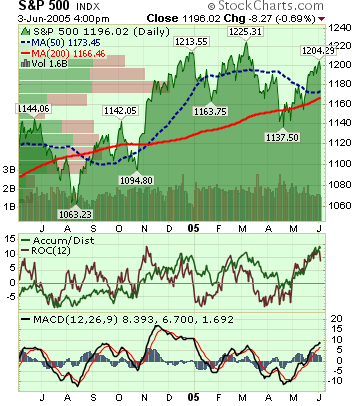Bloomberg:
- Wal-Mart Stores said June sales at its US stores open at least a year are rising within its forecast as groceries led the week's gains for the 18th time in the past 21 weeks.
- President Bush in his weekly radio address today called on Congress to "sustain" the US economy by passing an energy bill, limiting growth in federal spending, expanding free trade with Central America and adopting his proposal to shift a small fraction of Social Security payroll taxes into individually owned personal accounts.
- Shares of Asian steelmakers such as Posco and BluScope Steel fell over the last three months and investors such as Gary Armor said they expect further losses. "Rising Chinese production is colliding with a fall-off in global demand," said Armor, who helps manage $2.9 billion at AMP Capital Investors in Sydney.
- Citigroup and Nordea Bank AB, the two biggest arrangers of loans to buy ships, say they may raise interest rates on borrowings to fund a record $159 billion of new vessels ordered during the past three years.
New York Times:
- Peet's Coffee & Tea is expanding in the western US beyond the San Francisco Bay Area to win more customers.
- The US Department of Homeland Security advocates the use of sophisticated machines to detect explosives and more guards in screening lands to improve airline security.
- The ACLU has been shredding some documents over the objections of its records manager and the organization's own policies.
- Bristol-Myers Squibb may pay fines of almost $300 million to settle a government investigation of accounting practices.
LA Times:
- Mark McClellan, director of the Medicare system, has proposed steps to give US drug regulators faster alerts about harmful, unintended side effects in prescriptions issued to 43 million people.
- Occidental Petroleum's recent oil exploration contracts and financial performance may make it a takeover for larger oil companies.
Cnetnews.com:
- Apple Computer will unveil plans to switch to chips from Intel Corp. from those made by IBM.
Financial Times:
- European Union leaders are pressuring UK prime Minister Tony Blair to give up some of the country's EU budget refund or risk pushing Europe into deeper political disorder.
- Administrators looking after about a third of the world's hedge-fund assets are so overloaded they could end up mis-pricing credit instruments.
- Crude oil futures are rising to a six-week high in NY, after Exxon Mobil and Hovensa LLC shut down equipment at two refineries in the US.
Daily Telegraph:
- Asbestos injury claims from more than 730,000 people have cost about $70 billion to US businesses and insurance companies. Claimants received about 42 cents of every dollar spent on asbestos litigation.
Le Parisien:
- Europe's common currency, the euro, isn't threatened by votes in France and the Netherlands to reject the European Union constitution, said Bank of France Governor Christian Noyer.
Globe and Mail:
- Research in Motion Ltd. is "actively" looking at potential acquisitions.
Sunday Times:
- Viacom may be interested in buying Telewest Global's Living and Challenge UK cable tv channels for as much as $1.45 billion.
- UK Prime Minister Tony Blair is determined to abandon the European Constitution after its rejection by French and Dutch voters last week.
Observer:
- MBNA plans to bid $1.63 billion for the British Internet bank Egg Plc.
Independent:
- The US Department of Justice has stepped up its campaign against online gambling over the past few months.
Haaretz:
- Google plans to set up an Israeli subsidiary that will create and operate a Hebrew version of its portal.
Globes:
- The NYSE has begun a campaign to coax Israeli companies into listing their shares.
China Business News:
- China Deputy Finance Minister Lou Jiwei said the country isn't yet ready for a floating currency because the financial system isn't mature enough.
Weekend Recommendations
Bulls and Bears:
- Had guests that were positive on KFX, SYMC, EXPD, DV, TEVA, mixed on GOOG, SIMGE, IBN and negative on TELK.
Forbes on Fox:
- Had guests that were positive on GE, BRCM, GS and mixed on SSL, KYO, BR.
Cashin' In:
- Had guests that were positive on MIC, IJR, XXIA, HLEX, mixed on PFE and negative on CHD.
Cavuto on Business:
- Had guests that were positive on FINL and mixed on LOW.
Barron's:
- Had positive comments on EBAY, WWY, MRO and AIG.
Goldman Sachs:
- Reiterated Outperform on IBM and FCEA.
Night Trading
Asian indices are -.50% to +.50% on average.
S&P 500 indicated -.01%.
NASDAQ 100 indicated +.03%.
Morning Preview
US AM Market Call
NASDAQ 100 Pre-Market Indicator/Heat Map
Pre-market Commentary
Before the Bell CNBC Video(bottom right)
Global Commentary
Asian Indices
European Indices
Top 20 Business Stories
In Play
Bond Ticker
Daily Stock Events
Macro Calls
Rasmussen Consumer/Investor Daily Indices
CNBC Guest Schedule
Earnings of Note
Company/Estimate
FCEL/-.40
JOSB/.46
ZQK/.27
Splits
BEBE 3-for-2
MUR 2-for-1
NST 2-for-1
SWN 2-for-1
Economic Releases
None of note
BOTTOM LINE: Asian Indices are mixed as losses in China are being offset by gains in India. I expect US stocks to open modestly lower as oil climbs back above $55/bbl. and apprehension rises ahead of the Fed's Greenspan's comments. The Portfolio is 75% net long heading into the week.
